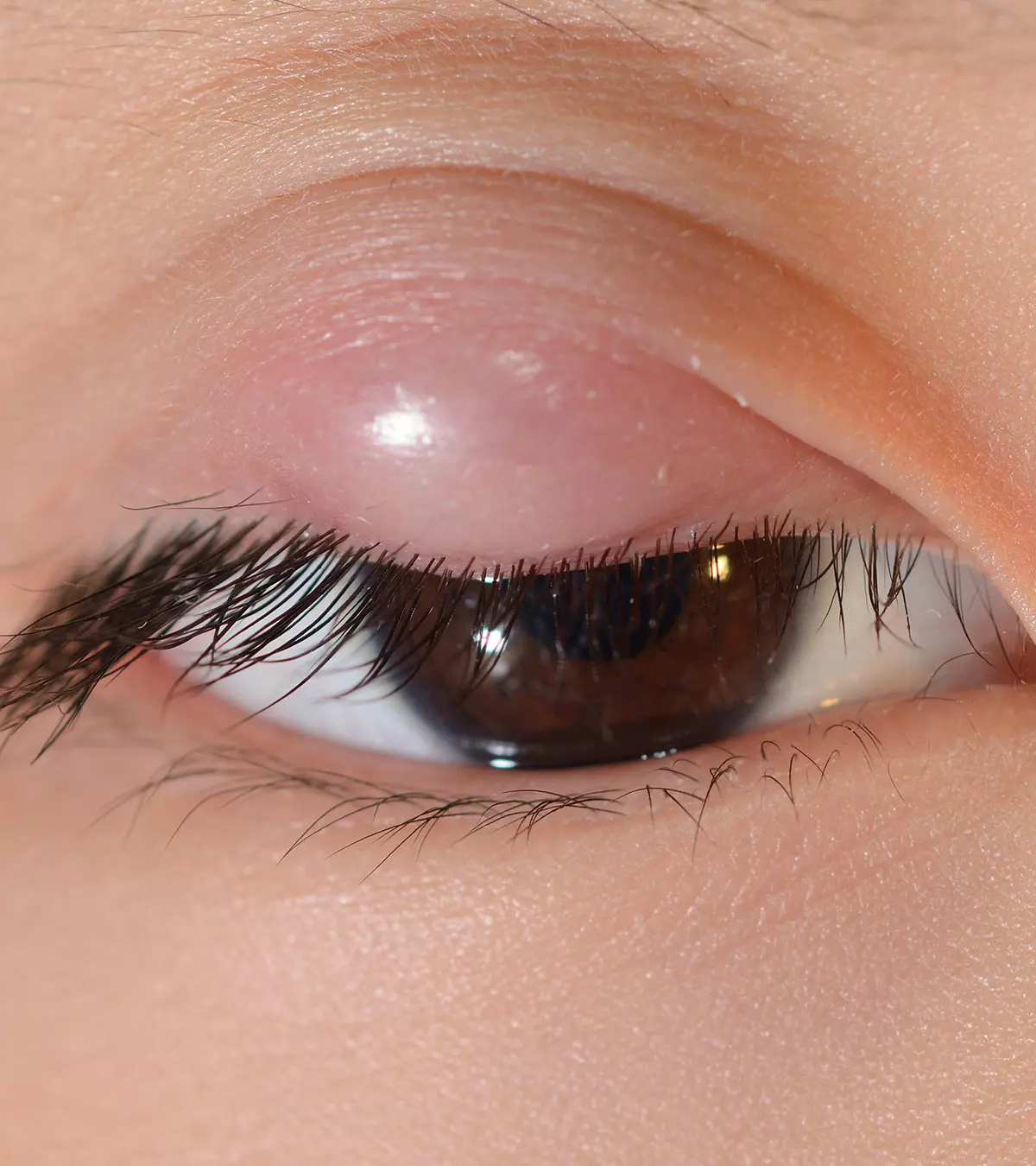
It may be tough to ensure your children’s safety all of the time, especially when you cannot be with them constantly. Hence, giving them lessons on road safety for kids can be useful when they walk to school, take the bus, or go outside to play.
According to the Centers for Disease Control and Prevention, crash injuries are the leading cause of death for people aged five to 29. Read this post to learn more about the importance of road safety rules and regulations for children, some important rules and tips to keep them safe on the road, and some road safety games to help them learn the rules in a fun manner. This post also includes some road safety facts that may be useful for your child.
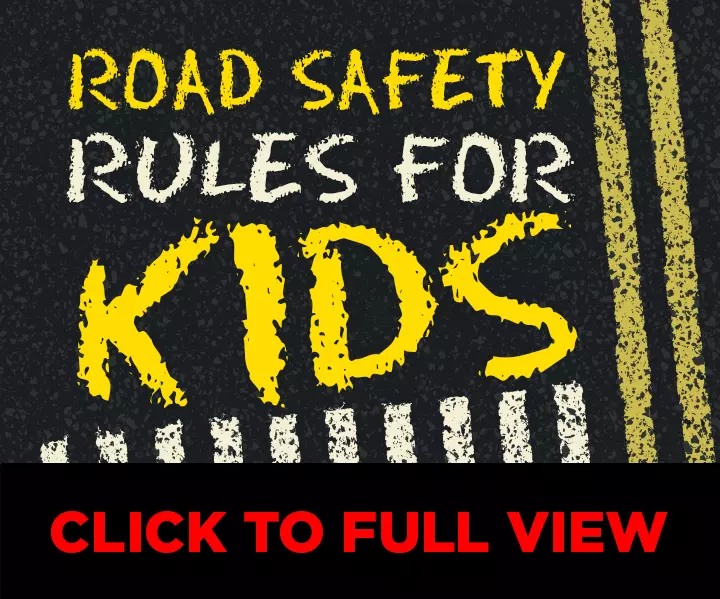
Key Pointers
- Educating children about traffic rules and pedestrian safety is essential.
- The consequences of using mobile phones while driving must be explained to kids.
- Children should not use headphones while bicycling.
- Practicing basic road safety tactics and rules, such as walking through sidewalks and following crosswalks, with children can be helpful.
Importance Of Road Safety Rules and Regulations For Kids
Unlike adults, children do not have the maturity to know what to do and what not when walking on the roads.
They are not fully aware of the safety rules on the road. Without adult supervision and proper knowledge of road safety rules, children can put themselves at risk. According to a National Highway Traffic Safety Administration report for 2014, 3% of the people who died due to road accidents were children (1). Statistics also show that 480 kids were injured every day due to road accidents in the same year. What’s more disturbing is that of the 4,884 pedestrians who were killed in road accidents, 207 were kids.
Teaching children about road safety helps prepare them for real-life situations and instills a sense of responsibility and caution. Learning through educational programs and resources can further reinforce their understanding. Ensure that they understand what you are saying by practicing it with them.
Keep reading for more road and traffic safety rules and information for your kids.
13 Rules To Ensure Road Safety For Kids
While it is important for children to know about road safety rules and regulations, they should not be given more information than they can handle.
Krista Elkins, a paramedic and registered nurse from Bozeman, Montana, says, “Accidents on the road often involve children on their bicycles. They get excited, racing through the wind with wheels beneath them, and unfortunately, they forget the close attention required when obeying the rules of the road. It is critical to teach children that whether they are riding their bikes, walking, running, or playing, it is important to stop completely, listen to traffic, and look both ways twice before crossing the road.
“They need to be taught that cars have the right of way on the road. They always need to assume that a car will not see them. Children need to be taught the serious consequences of getting hit by a car. Parents should teach them about hidden driveways or road entrances. Parents should hold their hands if their child is very young.”
Here are a few basic road safety rules for children that you can begin with (2) (3) .
1. Know Your Signals
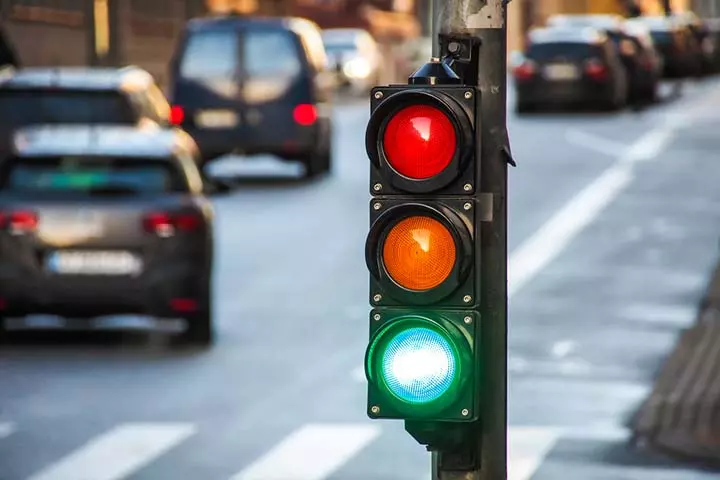
Image: Shutterstock
Help your kid learn about the traffic lights and signs, and what each color indicates.
- Green means ‘go’: Only when the signal turns ‘green’, vehicles move ahead.
- Red means to ‘stop’: When the signal turns red, all the vehicles have to stop.
- Yellow means to slow down: When the signal turns yellow, vehicles should slow down and prepare to stop.
- The ‘Walk’ or a walking man symbol at intersections is for pedestrians. Cross the road only if these signs turn green. But look to the left and right to ensure no vehicles are approaching.
- Never cross the road if the sign says ‘Don’t Walk’ or if the walking man symbol turns red.
Sometimes a hand symbol is used instead of the walking man or ‘Walk’ signals. Tell your kid about that too. If there are other symbols for pedestrians, you should make it a point to let them know. Gradually, teach your children about the other essential traffic signals they should know.
2. Stop, Look, And Cross
Your child may have to walk to school or the bus stop and back. They may only have to cross the street after the school bus drops them off. Even if they don’t, they may have to cross the street to get to a friend’s house or a neighbor’s. Whatever the case is, you should teach your kids to cross the road safely. Here’s how you can help them learn.
Always look for signals and use the pedestrian crossing to cross the road. In the absence of such markings, here is what you should do:
- Look to your right and then to the left and back to the right to see if there are any approaching vehicles.
- If yes, wait for the vehicle to pass and then cross the road.
- Never cross at bends.
- Never cross between stationary vehicles.
Adults should always accompany children aged less than six and hold their hand when crossing the street.
Leticia, a mother and a blogger, shares how she taught her child the safety rules of crossing the road. She says, “As we walked along the footpath, occasionally he would walk towards the road, so I asked him, ‘Do you want to cross the road?’ Ok. As we approach the curb, I say, ‘When we get to the road, we must stop!’ And I do an exaggerated stop with my feet and put both my hands up in a stop sign. Then I squat down next to him so I am at eye level with him and point up the street. ‘Any cars this way? No.’ ‘Any cars that way? No.’ ‘Then? Can we? Go.’ If there is a car, I say, ‘Any cars this way? Yes! Look, there’s a car. So? We must stop.’ Then I start again until there are no cars and we can go! After three days of doing this on our evening walk, I was so happy to see him stand at the edge of the road and try to do it. In fact, it was drop-dead adorable (i).”
3. Pay Attention – Listen
Teach your kids that they may not always be able to see an oncoming vehicle, especially if they are standing near a bend. Therefore, they should listen to know if a vehicle is approaching. Cars and other vehicles on the road often use the “horn” at bends and at unmanned intersections to indicate that they are nearing. Tell your children:
- If they hear a horn, stop and look to the left and right to see if any vehicle is approaching.
- Listen for engine sounds nearby to know if there is a moving vehicle – explain how a loud noise indicates the vehicle is nearby, and a faint sound means it is away. The sound of tires also means that a vehicle is approaching.
4. Don’t Run On Roads
Children may not always have patience and may tend to run across the street to get to the other side. They may also run along the road in your neighborhood while playing. Tell your kids never to run across or along the road. Children can get distracted easily and leave their guardian’s hand to run or sprint away.
Teach your kids to stay calm on the road and never to run or sprint.
5. Always Use Sidewalks
Teach your kids to use the sidewalk when walking on the road. Set an example for them by using the walking paths yourself. Whether it is a busy street or not, encourage your kid to use the sidewalk to stay safe on the road.
If there are no sidewalks, teach them to walk on the left side of the road to face oncoming traffic.
6. Crossroads and Pedestrian Crossing
Kids have a tendency just to sprint across the street, anywhere they like. That can be dangerous as passing vehicles do not slow down unless there is a signal or a crossroad. Tell your kids to cross only at an intersection and use the pedestrian crossing. If they are in a small neighborhood where there is no crossroad or marked crossing, they should follow the rules mentioned above.
Lessons on pedestrian safety for kids are important and should be included in the school curriculum as well.
7. Never Stick Hands Outside The Vehicle
Kids tend to put their hands out of the school bus even when it is moving. Some of them may even put their head out to look back and wave. This is common with students taking the school bus. It may seem like a fun idea but sticking hands or head out of a moving vehicle can be highly dangerous. If children are not careful, they could be hit by vehicles approaching from the opposite direction or they can be hit by things that are close to the road, like signs and trees.
8. Never Cross Road At Bends
Bends are the blind spots for motorists. When you cross at a bend, you do not give the vehicle drivers enough time to spot you and stop the car. Tell your kid never to cross at a bend as that can increase the chances of them getting hurt.
9. Staying Safe On A Bicycle
If you have an older kid who rides his bike to school or around the neighborhood, make sure he is aware of and follows the following cycling rules to stay safe on the road.
- Helmet safety is of utmost importance; so it is vital to encourage your child to wear a helmet when riding a bike.
- Check if the bicycle is in working condition before using it – check for breaks and light, if using at night.
- Always use the bicycle lane. In its absence, ride the bike on the extreme right or left side (whichever is right in your country) of the road and move along with traffic. Keep your eyes and ears open to make way for larger and faster vehicles behind you.
- Always use a light in areas with poor visibility and at night, to be easily noticed by motorists. It is helpful to wear reflective material and flashing lights to help motorists notice you in the dark.
Do not allow kids to ride a cycle on busy streets without parental supervision.
 Quick tip
Quick tip10. Staying Safe Inside A Moving Vehicle
In a moving car, you can make sure that your kid is safe with the help of a car seat or seat belts. To see that they are safe in a moving vehicle without you, make sure they learn and follow these simple rules:
- Never stand inside a moving vehicle, especially a school bus or van.
- Students should not move around inside a moving school bus.
- Stay seated and hold on to the hard rail inside the bus for support, until the vehicle comes to a stop.
- Do not put any part of the body outside the window of a moving vehicle.
11. Always Get Out At The Curb Side
If your kid takes the school bus every day, help them remember these safety tips.
- Start early and be on time to avoid running for the bus.
- Always stand in the queue when boarding and alighting the bus.
- Always get off the curb side when getting off a car or the bus to prevent being an obstruction to the other vehicles on the road.
 Quick tip
Quick tip12. Be Seen, Stay Safe
Dressing in black may be a bad idea when you want to walk at night. It is important that vehicle drivers notice you if you want to stay safe. To be seen:
- Wear light colored clothes or reflective material when walking or biking at night.
- Wear bright clothes during the day.
- Wear lights or flashing lights to help motorists see you at night.
- Wave your hand if you want to indicate your presence to an incoming vehicle.
13. Don’t Rush
Children can get excited and rush in an attempt to get to a place or meet someone. That can be dangerous. Teach your kids to:
- Not rush when getting into or off a vehicle as it can be hazardous.
- Not get distracted or suddenly drag the parent or guardian in a particular direction as this can throw the adult off guard.
- Stay calm and do not rush when walking on the street.
- Not open the car doors suddenly as they get into a habit of opening the doors only after you say so.
- Do not play in the bus bay or on the roads.
According to the Centers for Disease Control and Prevention (CDC), 13,049 young people died in the US in 2000 due to motor vehicle-related injuries (13.62 deaths per 100,000 people). Two decades later, there has been a nearly 40% decrease, with 8234 motor vehicle traffic deaths (8.31 deaths per 100,000 people) recorded in 2020, as depicted in the graph below.

Percentage of mortality in children and young adults due to motor vehicle crashes (2000-2020)
Source: Crossing Lines — A Change in the Leading Cause of Death among U.S. Children;The New England Journal of Medicine7 Tips To Keep Your Child Safe On Roads
Besides teaching about road safety rules for kids, parents should also keep in mind the following tips to ensure that their children stay safe on the road.
- Buckle up! – Ensure that your child always wears the seat belt, or is secured in a car seat.
- Use the child lock feature to prevent your kids from opening car doors by themselves.
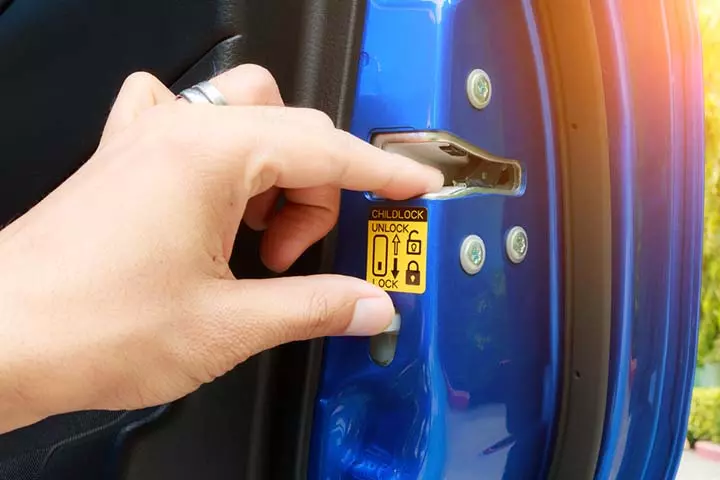
Image: Shutterstock
- Teach them about the rules practically – take them for walks and cycling, and teach them how to do it right.
- Exhibit patience when driving – set an example for your kids to be calm and not rush on the road. you may also consider displaying defensive driving techniques.
- Comment on getting eye contact with pedestrians crossing in front of the car at an intersection or crosswalk. Reflect that this lets both the driver and the pedestrian know that the pedestrian has been noticed.
- Be punctual and disciplined to avoid speeding and rash driving.
- Do not use mobile phones or other gadgets when driving.
- Never leave your kids alone in the car.
Road Safety Games & Activities
One of the best ways to teach your kids something important is play. Here are a few road safety activities you can rely on to help your child learn about road safety.
- Have a discussion – give your child a scenario and ask them what they should do. For example, ask “You are playing, and your ball rolls into the middle of the road. What would you do?” Or, you can ask “You are getting late to school, so you should run to the school bus bay, correct?” and see what they say.
- Draw or paint road and traffic signs or posters to help them remember better.
- See if you can create a fun road safety song with the signs and what the signs mean.
- Crosswords are excellent learning tools for older kids. You can find road safety education crosswords for kids online (4).

Image: Shutterstock
- Play a guessing game – play noises or sounds that they are likely to hear on the street and ask them what it is.
- Use activity sheets to teach your kids about road safety and road hazards. You can download road safety education worksheets for different age groups on the internet. Automobile companies like BMW have free resources online that can be used to educate your child about road safety (3). You can also download the Renault ‘Safety For All’ app for interactive road safety lessons (5).
- For younger children, you can make a map of roads and intersections, and use toy cars and toy people to act out safety scenarios. You can also draw out road signs on the map.
Road Safety Facts For Kids To Know
Did You Know?
- Vulnerable road users like pedestrians, cyclists, and bikers account for around 50% of deaths due to road accidents.
- Wearing right fitted, quality helmets reduces the chance of injury and death due to crash by around 40% (6).
- Reducing or controlling the speed can reduce the chances of an injury during an accident.
- According to the CDC, child and infant car seats can decrease the risk of serious injuries in children due to a car crash by around 70 to 80% (7). Also, WHO suggests that making child restraint mandatory in vehicles can decrease child deaths by about 60% (6).
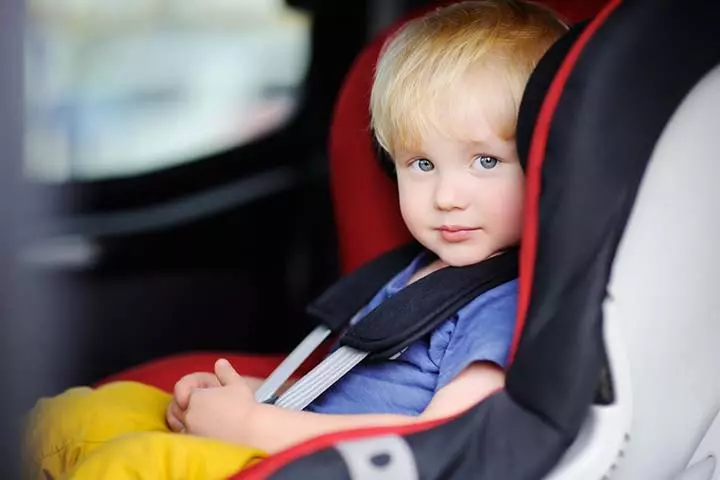
Image: Shutterstock
- The chances of death by accident can be decreased by 51% with the proper use of seat belts (6) .
- For every 1km/h that you reduce your speed by, you mitigate the risk of accident by 2%.
 Did you know?
Did you know?Frequently Asked Questions
1. What is road safety awareness?
Understanding the traffic rules and regulations is essential for walking or driving safely on the roads while preventing accidents and other mishaps. Road safety awareness helps one learn about the rules regarding traffic lights, crossing the roads, walkways, animal safety, drunk driving prevention, speed limits, etc. The safety of pedestrians, stray animals, and motorists can be ensured when road safety is taught early on in life.
2. What precautions should be taken while crossing the road?
To safely cross the road, one must follow precautions such as being alert and attentive, waiting for the red light for vehicles and green for pedestrians, using the zebra crossing, and never multitasking or using a mobile phone.
3. Why should we always wear a seatbelt in the car?
It is important to wear a seat belt inside a car as it helps keep one safe and secure inside the vehicle in case of a collision (10).
4. What are the dangers of using a phone while walking or cycling on the road?
Research conducted by the Japan Automobile Federation (JAF) reported that people who used their phones while crossing the road were prone to missing red lights and collisions, which could result in fatal outcomes (11).
Teaching road safety to kids or for that matter, any general safety rules for children, is important as they tend to spend the most time outdoors exploring and playing. You can begin explaining traffic lights and signals so they can follow them. Teaching children road safety is a fun task, too, as you can imbibe these rules in many games for a fun-learning session. You may also plan a trip around your town that solely focuses on teaching your child road safety tips. This post has covered you with most tips, so bookmark it.
Infographic: Rules To Ensure Road Safety For Children
Parents can’t always be around children when they are playing outdoors or on the road. So, you should brief them on road safety rules to prevent accidents. The infographic below presents the precautions children should take when they are by themselves on the road. Share it with your child! Illustration: Momjunction Design Team
Illustration: Important Road Safety Rules To Teach Your Children

Image: Stable Diffusion/MomJunction Design Team
Join Tia and Tofu as they set out on a thrilling and instructive expedition to teach children about traffic regulations and road safety.
Personal Experience: Source
MomJunction articles include first-hand experiences to provide you with better insights through real-life narratives. Here are the sources of personal accounts referenced in this article.
i. What’s worked for my son with down syndrome…road safety.https://embracingwade.wordpress.com/2015/06/07/whats-worked-for-my-son-with-down-syndrome-road-safety/
References
- Traffic Safety Facts.
https://crashstats.nhtsa.dot.gov/Api/Public/ViewPublication/812271 - Pedestrian safety and road safety for kids.
https://raisingchildren.net.au/toddlers/safety/car-pedestrian-safety/pedestrian-safety - Back to School Road Safety Tips.
https://jis.gov.jm/information/tips/back-to-school-road-safety-tips/ - Governor’s Traffic Safety Committee.
https://trafficsafety.ny.gov/?utm_medium=301&utm_source=www.safeny.ny.gov - SAFETY BY RENAULT.
https://www.renault.co.uk/safety.html - Road traffic injuries
https://www.who.int/news-room/fact-sheets/detail/road-traffic-injuries - Preventing Child Passenger Injury.
https://www.cdc.gov/child-passenger-safety/prevention/?CDC_AAref_Val=https://www.cdc.gov/transportationsafety/child_passenger_safety/cps-factsheet.html - Teaching Children Bicycle Safety.
https://www.saintlukeskc.org/health-library/teaching-children-bicycle-safety - Staying Safe in the Car and on the Bus.
https://kidshealth.org/en/kids/car-safety.html - Seat Belts.
https://www.nhtsa.gov/vehicle-safety/seat-belts - Glued to our screens – The dangers of texting while walking and cycling
https://www.fia.com/news/glued-our-screens-%E2%80%93-dangers-texting-while-walking-and-cycling
Community Experiences
Join the conversation and become a part of our nurturing community! Share your stories, experiences, and insights to connect with fellow parents.
Read full bio of Katherine Paxton
- Krista Elkins is a registered nurse and paramedic with experience in emergency, intensive care, primary care, specialty care, and psychiatry. She holds a bachelor's degree in Health Sciences from the University of Hawaii at Manoa and is a graduate of Excelsior University's registered nursing program.
 Krista Elkins is a registered nurse and paramedic with experience in emergency, intensive care, primary care, specialty care, and psychiatry. She holds a bachelor's degree in Health Sciences from the University of Hawaii at Manoa and is a graduate of Excelsior University's registered nursing program.
Krista Elkins is a registered nurse and paramedic with experience in emergency, intensive care, primary care, specialty care, and psychiatry. She holds a bachelor's degree in Health Sciences from the University of Hawaii at Manoa and is a graduate of Excelsior University's registered nursing program.
Read full bio of Harshita Makvana
Read full bio of Swati Patwal
Read full bio of Kavita Kankani





